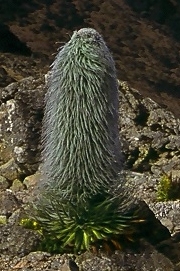Our website is made possible by displaying online advertisements to our visitors.
Please consider supporting us by disabling your ad blocker.
Lobelia telekii
| Lobelia telekii | |
|---|---|

| |
| Scientific classification | |
| Kingdom: | Plantae |
| Clade: | Tracheophytes |
| Clade: | Angiosperms |
| Clade: | Eudicots |
| Clade: | Asterids |
| Order: | Asterales |
| Family: | Campanulaceae |
| Genus: | Lobelia |
| Species: | L. telekii
|
| Binomial name | |
| Lobelia telekii Scwheinf.
| |

Lobelia telekii is a species of flowering plant in the family Campanulaceae, that is found only in the alpine zones of Mount Kenya, Mount Elgon, and the Aberdare Mountains of East Africa. It occurs at higher altitudes on well-drained sloped hillsides. It is a semelparous species, putting all its reproductive effort into producing single large inflorescence up to 3 metres (10 ft) tall, and then dying.[1] Inflorescences of L. telekii also possesses a large pith-volume for internal water storage and marcescent foliage which could provide insulation.[2] It secretes a polysaccharide into this reservoir, which may be useful for its survival in the cold climate. [3] The plant is named after the Austro-Hungarian explorer, Count Sámuel Teleki.
L. telekii plants usually consist of a single rosette, which grows for several decades, flowers once, and then dies. However, a very small number of plants have multiple rosettes connected by an underground stem.[1] Each flower is subtended by a long hairy bract, and the overall appearance has led to the nickname "Cousin Itt lobelia".
The bird-pollinated flowers[4][5] of L. telekii are hidden among the large bracts within the inflorescence. The leaves and bracts are blue-green, and the flowers purple.[6] Each flower can produce up to several hundred small (<1mm diameter) dark seeds, which are passively dispersed.
On Mount Kenya, Lobelia telekii occurs at elevations of 3,500–5,000 metres (11,500–16,400 ft). It inhabits the drier hill slopes, while its close relative Lobelia keniensis prefers the moister valley bottoms. Partially fertile hybrids do occur. The hill slopes often have rocky moraines that are home to Mount Kenya rock hyrax, which sometimes eat lobelia leaves and inflorescences,[7] but herbivores are generally deterred by the lobelia's bitter toxic sap, which contains alkaloids, probably including lobeline.
- ^ a b Young, Truman P. (1990). "Evolution of semelparity in Mount Kenya lobelias". Evolutionary Ecology. 4 (2). Chapman and Hall Ltd: 157–171. doi:10.1007/BF02270913. S2CID 25993809.
- ^ Cite error: The named reference
subsectionwas invoked but never defined (see the help page). - ^ Krog, J.O. (1979). "Thermal buffering in afro-alpine plants due to nucleating agent-induced water freezing". Nature. 282 (5736): 300–301. Bibcode:1979Natur.282..300K. doi:10.1038/282300a0. S2CID 4368345.
- ^ Young, Truman P. (1982). "Bird visitation, seed set, and germination rates in two species of Lobelia on Mount Kenya". Ecology. 68 (6): 1983–1986. doi:10.2307/1940139. JSTOR 1940139.
- ^ Smith, Alan P.; Truman P. Young (1987). "Tropical Alpine Plant Ecology". Annual Review of Ecology and Systematics. 18 (1): 137–158. doi:10.1146/annurev.es.18.110187.001033.
- ^ Mabberley, D. J. (1975). "The Giant Lobelias: Pachycauly, biogeography, ornithophily and continental drift". New Phytologist. 74 (2): 365–374. doi:10.1111/j.1469-8137.1975.tb02623.x.
- ^ Young, Truman P. (1984). "The comparative demography of semelparous Lobelia telekii and iteroparous Lobelia keniensis on Mount Kenya". Journal of Ecology. 72 (2): 637–650. doi:10.2307/2260073. JSTOR 2260073.
Previous Page Next Page


